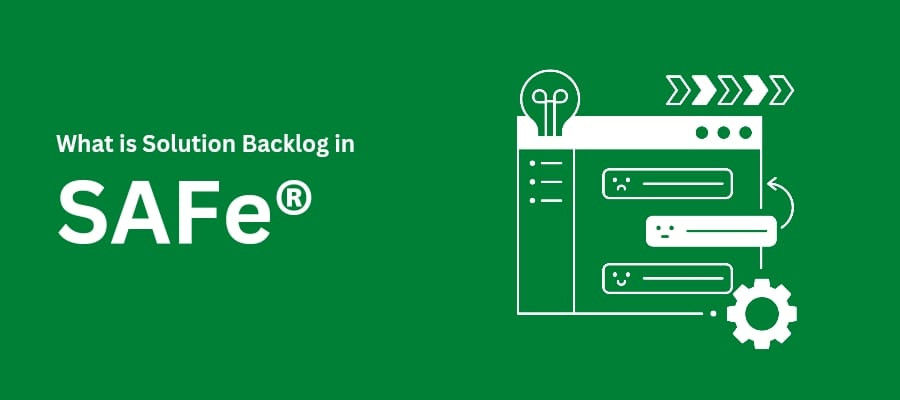What is Solution Backlog in SAFe?

In Agile, a backlog is defined as the set of requirements and supported activities that contribute to creating the desired Product Vision. Backlogs come in multiple forms, such as User Stories, Epics, Features, Spikes, Technical Debts, Bugs, Product Backlog Items, etc. The more you deal with backlogs, the better you realize the different types of backlogs including:
- Product Backlog
- Program Backlog
- Solution Backlog
- Team Backlog
Here, we will discuss Solution Backlog and its scope in the Scaled Agile Framework (SAFe). We will explore how the Solution Backlog Items appear, evolve, and end throughout the Agile product development cycle.
Solution Backlog Definition:
Solution Backlog is the data set containing upcoming Solution Train capabilities and enablers, each combining multiple Agile Release Trains (ARTs). It is intended to improve the Solution Train functionalities and build its entire architectural runway. The Solution management team and the Product Owner are responsible for handling the Solution Backlog. Naturally, it is the outcome of continuous exploration and research activities that promote smooth collaboration between internal Developers and external stakeholders such as Product Managers, Business Owners, Product Owners, End users, System and Solution Architects, etc.
Refining The Solution Backlog:
Solution Trains and ARTs run with an 8 to 12-week duration in which Program Increment (PI), planning, development, demo, and Inspect & Adapt (I&A) happen. This step-by-step activity plan drives Solution Backlog readiness.
The Agile Leader can perform pre-PI planning without considering any well-elaborated backlog items that can bring unacceptable risks in the upcoming PI. However, Solution Backlog refinement in Agile typically includes:
- Reviewing and updating the Product Backlog Item (PBI) definition.
- Developing acceptance criteria based on the hypothesis.
- Working with the Scrum Team to conduct Sprint Planning
- Establishing technical scope and feasibility based on the estimates.
- Analyzing techniques to split Backlog Items into smaller blocks with incremental value.
- Identifying the enablers to support new features based on the Product Goal.
- Adding capabilities and establishing the team’s capacity allocation.
The time between Solution Backlog Refinement and PI planning is a busy time for the Certified Scrum Product Owner and the Solution Manager. They are constantly refining their Solution Backlogs in preparation for the upcoming PI planning. Overall, the Solution Backlog Refinement process helps them achieve backlog readiness for the upcoming Program Increment (PI).
Prioritizing The Solution Backlogs:
This activity is a critical economic driver for the Agile Transformation with the ultimate Product Goal. The Product Owner uses the Weighted Shortest Job First (WSFJ) method to sequence Solution Backlog jobs efficiently.
The formula for calculating WSJF =
((User value - Business value) + Time criticality + Risk reduction & opportunity enablement) / Job size
Preform PI Planning For Final Solution Backlog Preparation:
The time before PI planning is a very critical time. The Solution Manager needs to do the final Solution Backlog preparation. The Product Owner updates the Product Vision briefings and collaborates with the Solution Manager to socialize the Solution Backlog further before the PI planning event. The System Engineers, Developers, and Solution Architects also update the corresponding enabler definitions based on the User Stories and Use Cases. It’s ideal for demonstrating how the Product Features and Capabilities will deliver the end-user value.
Optimizing Solution Integrity with Capacity Allocation:
Every ART in a Solution Train faces multiple challenges related to balancing the Solution Backlog of product features and capabilities. While the Product Owner focuses on the product capabilities and features the customers need, the Solution Architect focuses on creating a robust technology solution.
The Solution Manager invests in the product’s architectural setup and prototyping. It offers him enough time to explore the customer requirements before finalizing the Product Strategy for future PIs. The Solution Manager allows the Developers to create prototype models that offer better visibility into the critical problem areas.
At each PI boundary, the Product Owner agrees on the percentage of work that is required to build the new features or capabilities. This activity is part of the Capacity Planning to optimize the Solution Integrity. Solution Architects and Developers get the authority to prioritize their enabler activities. On the other hand, the Agile Leader gets the authority to prioritize Solution Backlog Items. The Agile teams agree to collaborate and improve productivity to maximize customer value.
Summing Up Solution Backlog in SAFe:
The Scaled Agile Framework (SAFe) is a set of scaled Agile workflow patterns that prioritizes various Agile practices, such as Scrum, Kanban, XP, etc., at an enterprise scale. The SAFe framework includes structured guidance on the roles and responsibilities of the Product Owner, Solution Architects, and System Engineers.
In SAFe, Solution Backlog Items align business commitments with team collaboration and stable delivery across the Agile teams. Solution Backlogs are key action areas in Agile software development. It follows the Solution Train that incorporates several ARTs to make the backlogs short and manageable. This way, it becomes easier for the Agile Leader to monitor the team’s daily activities. Hopefully, this guide has helped you understand the Solution Backlog in SAFe!
Reference
- Scaled agile framework - Wikipedia



